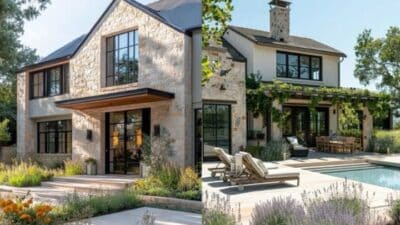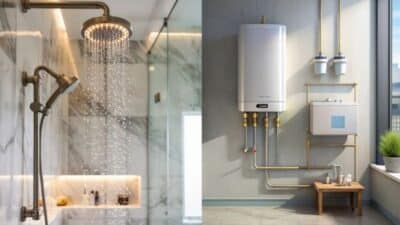Creating a stylish living room doesn’t require an interior design degree or unlimited budget. It’s about thoughtfully combining elements that reflect your personality while maintaining balance and harmony. The secret to a truly stylish living room lies in mixing carefully selected furniture with the right textures, colors, and accessories that create both visual interest and comfort.
Your living room serves as both a personal sanctuary and a space to welcome guests, making it worthy of special attention. As we move through 2025, design trends are embracing cozy yet classy aesthetics that prioritize both function and style. Taking inspiration from designers like Nate Berkus, today’s most inviting living rooms blend casual comfort with elegant touches that elevate the entire space.
Key Takeaways
- Balance functionality with aesthetic appeal by selecting furniture that complements your space’s dimensions and your lifestyle needs.
- Create visual interest through layered textures, from plush throw pillows to statement artwork and carefully chosen accent pieces.
- Establish a cohesive color palette that reflects your personal style while creating a welcoming atmosphere for both everyday living and entertaining.


Planning Your Space
The foundation of a stylish living room begins with thoughtful space planning. Proper layout and functional considerations will ensure your living room not only looks beautiful but serves your lifestyle needs effectively.
Living Room Layout
Start by measuring your living room dimensions and creating a floor plan. Allow 30-36 inches for walkways to ensure comfortable movement throughout the space. When positioning furniture, create conversation areas where seating faces each other at distances of 4-8 feet for optimal interaction.
Consider the focal point of your room—whether it’s a fireplace, window view, or television. Arrange your primary seating to face this element. For larger rooms, creating two distinct seating zones can maximize functionality and visual interest.
Furniture placement should account for traffic flow. Avoid blocking doorways or natural pathways through the room. Rugs can help define seating areas and add a layer of comfort and style to your layout.
Functional Design Considerations
Balance aesthetics with practicality by incorporating adequate storage solutions. Opt for coffee tables with drawers, ottomans with hidden compartments, or stylish baskets to minimize clutter while maintaining your design aesthetic.
Consider the primary activities that will take place in your living room. If you entertain frequently, arrange seating to facilitate conversation. For media rooms, position seating within comfortable viewing distance of the television (typically 1.5-2.5 times the screen’s diagonal measurement).
Lighting requires a three-tier approach: ambient lighting for overall illumination, task lighting for reading areas, and accent lighting to highlight architectural features or artwork. Include a mix of table lamps, floor lamps, and overhead fixtures for versatility.
Account for technology needs with accessible outlets and cable management solutions. Hide wires using cord covers or strategic furniture placement for a cleaner appearance that doesn’t sacrifice functionality.


Selecting Your Furniture
Choosing the right furniture pieces establishes the foundation of your living room’s style and functionality. The right selections balance comfort, aesthetics, and practical needs while reflecting your personal taste.
Sofas and Sectionals
Sofas serve as the centerpiece of your living room, so select one that balances comfort with style. When shopping, consider the scale relative to your space—oversized sectionals work well in larger rooms but can overwhelm smaller areas.
Fabric choice significantly impacts both appearance and longevity. Durable materials like microfiber and leather withstand daily use, while velvet and linen offer a more luxurious look. If you have children or pets, opt for stain-resistant options.
Think about your seating needs realistically. Sectionals provide maximum seating and can define separate areas within open floor plans. For smaller spaces, consider apartment-sized sofas or loveseats paired with an accent chair.
The sofa’s shape also influences your room’s style—clean lines work well in modern spaces, while rolled arms suit traditional aesthetics.
Accent Chairs and Coffee Tables
Accent chairs complement your sofa while adding visual interest and extra seating. Choose chairs with seat heights within 4 inches of your sofa to maintain visual harmony and comfort during conversations.
Consider the chair’s purpose—swivel chairs offer flexibility, recliners provide comfort, and statement chairs with bold fabrics or unique shapes add personality. Place chairs to facilitate conversation rather than pointing everything at the TV.
Your coffee table should balance functionality with style. The height should be slightly lower than or equal to your sofa’s seat height. Allow 12-18 inches between the table and seating for comfortable leg room.
Materials matter—glass tables create an airy feel in smaller spaces, while sturdy wood options provide warmth and durability. Consider tables with storage if you need to maximize functionality.
Scale is crucial—your coffee table should be approximately two-thirds the length of your sofa for proper proportion.


Styling With Textures and Fabrics
Textures transform a living room from flat to dynamic, adding depth and visual interest through varied surfaces and materials. The right mix of textiles creates a layered, inviting space that engages both sight and touch.
Rugs and Curtains
Rugs anchor your living space while introducing essential texture at ground level. Opt for natural fibers like wool, jute, or sisal for warmth and durability. High-pile shag adds luxury, while flatweave rugs offer subtle texture in busier rooms.
Consider layering rugs of different textures for added dimension—try a smaller hide or vintage rug atop a larger sisal base.
Curtains frame your windows while contributing significant textural elements. Linen provides casual elegance with natural slubs and drape. Velvet delivers rich depth and sound absorption. Sheer options filter light beautifully while adding gentle movement.
Mount curtain rods higher than window frames to create an illusion of height. Allow fabric to pool slightly on the floor for a luxurious finish.
Cushions and Throws
Cushions offer the quickest way to introduce textural variety to your living room. Mix 4-5 different textures rather than matching sets—combine velvet, linen, bouclé, and woven fabrics for visual interest.
Consider these texture combinations:
- Smooth + Rough: Silk cushions against tweed upholstery
- Matte + Shiny: Linen paired with metallic accents
- Soft + Hard: Plush throws on leather furniture
Arrange throws casually over sofa arms or chair backs rather than folding them precisely. This creates an inviting atmosphere and highlights their textural quality.
Introduce seasonal textures through your soft furnishings—lightweight cotton and linen for summer, chunky knits and faux fur for winter months. This approach keeps your living room feeling fresh year-round.


Choosing a Color Palette
Color selection forms the foundation of your living room’s personality and sets the mood for the entire space. A well-chosen palette can make your room feel larger, cozier, or more sophisticated depending on your design goals.
The Impact of Wall Paint
Wall paint serves as the canvas for your living room design. Soft blue walls create a serene atmosphere that works beautifully as a backdrop for both light and dark furniture. This versatile color promotes relaxation while maintaining a fresh, airy feel.
White walls remain a timeless choice that maximizes light reflection and creates the illusion of more space. They provide a blank slate that allows your furniture and accessories to stand out.
For a bold statement, black accent walls add drama and sophistication. While once considered too dark for living spaces, properly executed black walls can anchor a room and create stunning contrast.
Popular Wall Paint Color Combinations:
- Soft ivory + olive + black accents
- Crisp white + navy + warm wood tones
- Soft blue + white + gray accents
Coordinating Furniture and Accessories
Follow the 60-30-10 rule when selecting furniture and accessories. This means 60% of the room features your primary color, 30% your secondary color, and 10% an accent color.
Your largest pieces—sofas, rugs, and curtains—should generally align with your primary color. Consider neutral tones like beige, gray, or white for maximum flexibility.
Add depth with secondary colors in armchairs, ottomans, or accent tables. This creates visual interest without overwhelming the space.
Accessories offer perfect opportunities for bold accent colors. Pillows, throws, and artwork can introduce pops of vibrant hues against a more neutral backdrop.
Designer Tip: Cool tones like green and blue create calm, serene spaces, while warmer yellows and reds add energy and vibrancy to your living room.


Accessorizing for Visual Appeal
The right accessories transform an ordinary living room into a stylish, personalized space. Strategic placement of decorative elements adds depth, character, and visual interest without overwhelming your space.
Wall Art and Decor
Selecting the right wall decor establishes your living room’s personality and completes your design vision. Consider creating a gallery wall with a mix of framed photographs, prints, and paintings in varying sizes for a dynamic focal point.
Large statement pieces work wonderfully above sofas or mantels, instantly drawing attention and anchoring the room. For a cohesive look, choose art that incorporates colors from your existing palette.
Decorative mirrors serve dual purposes – they reflect light, making rooms appear larger, while also functioning as artistic elements. Position them opposite windows to maximize natural light distribution.
Textile wall hangings, metal sculptures, and dimensional pieces add textural contrast to flat walls. Don’t overcrowd your walls; leave breathing room between pieces to allow each item to make its statement.
Indoor Plants and Lighting Fixtures
Plants bring life, color, and improved air quality to your living space. Large floor plants like fiddle leaf figs or monstera create dramatic vertical interest in empty corners, while smaller potted varieties work beautifully on coffee tables and shelves.
For low-maintenance options, consider succulents or snake plants that thrive with minimal care. Group plants of varying heights and textures for a curated, natural display rather than distributing them evenly throughout the room.
Lighting dramatically impacts your room’s ambiance and functionality. Layer different light sources – combine overhead fixtures with floor lamps, table lamps, and accent lighting to create depth and flexibility.
Statement pendants or chandeliers serve as decorative centerpieces while providing essential illumination. Consider fixtures with metallic finishes that complement your hardware and add a touch of luxury to your space.
Strategic placement of table lamps on side tables creates intimate conversation zones. Adjustable reading lamps beside seating areas add functionality and visual interest to your thoughtfully accessorized living room.
- 11shares
- Facebook0
- Pinterest11
- Twitter0



